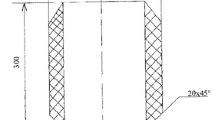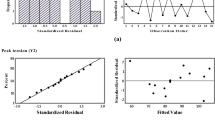Conclusions
-- The effect of the component air streams on yarn uniformity with respect to linear density has been established. This has afforded opportunity to find an optimum regime for yarn cooling in spinning from polymer melts. Analysis of the pulsations in air streams has made it possible to determine the basic sources for their origin and ways to reduce them.
-- A manufacturing control of the yarn cooling regime using anemometers has been proposed.
-- A way of intensifying the yarn cooling regime using an air jet on the yarn section after its initial hardening has been described.
-- It is recommended to use the method of investigating the process of yarn spinning by analysis of the component air streams in preparing fibres from polymer melts on any type of spinning equipment.
Similar content being viewed by others
Literature cited
A. B. Pakshver, Physico-Chemical Bases of the Man-Made Fibre Technology [in Russian], Khimiya, Moscow (1972).
S. P. Papkov, Physico-Chemical Bases for the Manufacture of Artificial and Synthetic Fibres [in Russian], Khimiya, Moscow (1972).
G. Klare, et al., Synthetic Polyamide Fibres [Russian translation], Moscow (1966).
M. P. Zverev, in coll.: Carbochain Synthetic Fibres [in Russian], Khimiya, Moscow (1973), pp. 490–589.
I. D. Pupyshev, New Methods of Control of the Process of Preparing Yarn from Polymer Melts [in Russian], NIITÉKhIM, Moscow, Obzor. Nizh. Ser. “Obshcheotraslevye Voprosy.” No. 1, (1985).
A. A. Zaitsev and L. V. Legut, Khim. Volokna, No. 6, 68–70 (1966).
L. D. Nichiporchik, Khim. Volokna, No. 6, 30–32 (1971).
L. M. Polovets, et al., Trudy VNIIMSV (Chernigov), Moscow No. 2, Part 2, 3–13 (1971).
I. D. Pupyshev, et al., Khim. Volokna, No. 1, 66–67 (1976).
I. D. Pupyshev and Yu. A. Negashev, Khim. Volokna, No. 2, 57–58 (1972).
N. N. Ryazynov, General Theory of Statistics [in Russian], Statistika, Moscow (1971).
M. Yu. Ivanitskaya, et al., Heterochain Fibres, V. M. Kharitonova (ed.), [in Russian], Khimiya, Moscow (1967).
Inventor's Certificate 1252404 (1986) (USSR).
Inventor's Certificate 827627 (1981) (USSR).
Inventor's Certificate 489819 (1975) (USSR).
Inventor's Certificate 626119 (1978) (USSR).
A. P. Zaitsev, et al., Trudy VNIIMSV, Mashinostroenie, Moscow (1968), No. 1, pp. 79–95.
S. I. Skripnik and N. V. Pavlovich, Izv. Vuzov, Ser. “Teckhnol. Leg. Prom-sti,” No. 3, 70–76 (1968).
K. E. Perepelkin, Khim. Volokna, No. 1, 3–12 (1968).
Inventor's Certificate 487170 (1975) (USSR).
Inventor's Certificate 968113 (1982) (USSR).
Additional information
Translated from Khimicheskie Volokna, No. 4, pp. 26–30, July–August, 1990.
Rights and permissions
About this article
Cite this article
Pupyshev, I.D., Zverev, M.P. Cooling yarns spun from polymer melts. Fibre Chem 22, 248–254 (1991). https://doi.org/10.1007/BF00548101
Issue Date:
DOI: https://doi.org/10.1007/BF00548101




